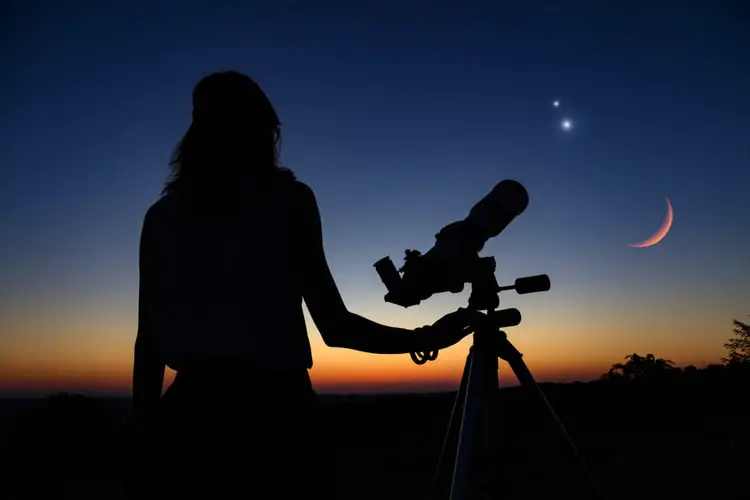You can go outside on any night and stare at the stars, but nothing beats bringing them closer through a telescope. Whether it’s for yourself, a loved one or the family as a whole, a telescope probably seems like something of a must-have item, but you might be concerned about the cost or quality.
Our astronomy expert, Richard J. Bartlett, has reviewed dozens of the best telescopes for beginners and has found the top 5, based on factors such as portability, image quality, aperture and value for money. After careful consideration, he chose the Zhumell Z100 Portable Telescope as his top pick. The telescope stood out from the rest thanks to its quality, ease-of-use and compact design. Read how he chose the top 5.
Image Credits: Orion Observer 70mm II AZ Refractor & SkyQuest XT6 – Orion Telescopes (http://www.telescope.com).
All Other Photos Credit: Richard J. Bartlett
If you’re interested in observing the night sky, you may also want check out our articles about getting started with stargazing and how to get your kids in on the astronomy fun. Once you’ve bought your scope, check out How to Use a Telescope: The Ultimate Beginner’s Guide.
Our Astronomy Expert’s Top 5 Telescopes for Beginners
Here are the top picks from our astronomy expert. Compare the ratings and features of different models.
| Expert’s Top Picks | Model | Rating | Ease of Use | Accessories | Value for Money |
|---|---|---|---|---|---|
| Best Overall | Zhumell Z100 Portable Telescope | ||||
| Best Budget Buy | Orion Observer 70mm II AZ Refractor Telescope | ||||
| Best for Camping | Celestron TravelScope 80 | ||||
| Best for Planets | Orion SkyQuest XT6 | ||||
| Best for Younger Kids | Celestron FirstScope |
*Ratings are on a scale of 1 to 5 and based on reviews, feedback, and opinions of actual customers
In This Article
Who Should Buy a Telescope?
- Beginners who want to see more – A lot of amateur astronomers start off by learning the night sky and then delving deeper with binoculars. While this is an excellent way to explore the sky and discover many of the wonders to be found there, binoculars are a little restrictive. They can help you to locate objects, but if you need a close-up view, you’ll need a telescope.
- Anyone looking for a fun family activity – If your family likes to regularly spend time together, then astronomy can be an excellent (and educational!) way to share some wonderful and memorable experiences. There isn’t a child alive that isn’t wowed by the view of the Moon through a telescope or by seeing the rings of Saturn for the first time – and many adults will have the same reaction!
Who Should Not Buy a Telescope?
- Absolute beginners – if you’re just getting into astronomy, the chances are you’ve never used a telescope before. You may not be very familiar with the night sky either, and without some basic knowledge in both regards, you could easily become frustrated and lose interest.
- Anyone expecting to see breathtakingly colorful sights – while there are a lot of beautiful sights to see in the night sky, you won’t see a lot of color (except with some stars.) You may have seen some wonderful images online and in magazines, filled with color, but the cameras used are much more sensitive to light than your eyes. It’s possible to see some faint color in nebulae, but nothing like the photos you’ve seen.
- Anyone hoping to interest a child – kids are naturally curious and inquisitive, but unless they’ve already shown an interest in space and/or astronomy, the chances are they won’t develop one simply because you’ve bought them a telescope. Unfortunately, it’s more likely that the telescope will remain unused and gathering dust in the corner.
Research Tips (from an Astronomy Expert)
As an astronomy expert, I often get asked how to choose the best binoculars for stargazing. Here are some tips and best practices to consider when making a buying decision. Be sure to do adequate research on the product you are considering purchasing to look for key features and ask your friends and family (especially your fellow stargazers) if they have any recommendations on the best astronomy binoculars for your specific needs.
- Stick to the quality brands – you might be tempted to buy a telescope from a gift store in a museum or from a general store, but this is often a bad idea. These telescopes are often cheaply produced and then sold in bulk to retailers, who can then mark up the price for a profit. As a general rule, it’s a good idea to stick to the major brands – Celestron, Orion, Meade, Zhumell, Apertura and Sky-Watcher – and avoid anything that brags about the “power” of the telescope. In theory, any telescope can magnify 1,000x, but unless it’s specifically built for such a high magnification, the view will be of terrible quality. Telescopes that boast of producing such a power (and they’re almost always small, cheaply produced items of poor quality) are little more than toys.
- Aperture is everything – when it comes to telescopes, aperture is everything. The aperture is the diameter of the lens or mirror the telescope uses to gather light. The larger the aperture, the more light it can gather. The more light it gathers, the fainter the objects you can see and the more detail you can see. Large aperture telescopes are often used for observing galaxies and planetary nebulae because those objects are often faint and small.
- Magnification isn’t everything – as mentioned earlier, almost any telescope is capable of magnifying 1,000x, but unless your scope has the aperture to back it up, you won’t be seeing much of anything. There comes a point where increasing the magnification is simply pointless because your scope is incapable of gathering any more light. It’s also harder to focus at a high magnification, and both these factors combine to produce nothing more than a blur. As such, every telescope has a maximum useful magnification. Opinions vary on exactly how the maximum is defined, but a quick calculation involves taking the aperture in millimeters and doubling it, or taking the aperture in inches and multiplying it by 50. For example, a small 70mm telescope has a maximum useful magnification of about 140x (70mm x 2) or 138x (2.76 inches x 50.)
- Consider its weight – do you want a telescope you can take camping or to a dark location? Then you’ll need to consider its weight, as this will have a huge impact on its portability. Ideally, you’ll want a scope with as much aperture as possible weighing as little as possible. There are also some scopes that are specifically designed for traveling (see the Best Telescope for Camping below) that are lightweight and can be easily transported to a remote location.
- Consider the accessories – many telescopes will come with two eyepieces, but there are some that are only supplied with one. You might also get lucky and find a scope that has three eyepieces included. Other scopes may provide a Barlow lens, which will typically double the magnification of any eyepiece attached to it. You might also get a red flashlight (to protect your night vision), a book, star chart, free software or a smartphone holder that can allow you to take photos through the eyepiece with your phone.
How Much Do They Cost?
Between $50 and $500
For most telescopes for beginners, you can expect to pay between $50-$500 and still get a high-quality product. That being said, the prices of telescopes vary widely based on a number of factors. Telescopes at the lower end of that price range can sometimes be made with cheap materials and inferior components to keep the price down. By comparison, more expensive telescopes are often made with high-quality optics, are well-constructed and are capable of producing some outstanding views. Very high-end telescopes can cost $2,000 or more. Models of this price are typically built for more experienced amateur astronomers looking to observe and photograph distant, faint objects like galaxies. As a beginner, it’s not necessary to spend top dollar on a telescope, as mid-priced models should deliver all the functionality you need to get started in astronomy.
Our Methodology: Why Trust Moon and Back
As an astronomy expert, I’ve spoken with many astronomers about the best telescopes for beginners on the market. Many of these products were chosen based on my professional experience as an astronomy expert combined with product feature considerations. I personally tested my top picks and other telescopes to find the best of the best based on aperture, focal length, maximum magnification and weight. The other two criteria (price and ease-of-use) were subjectively taken into account and generally used as a tie-breaker. For example, if two telescopes scored almost the same, I might have chosen one product over another due to its price and ease of use. My final five picks are ones I’d personally recommend to anyone in the market for a telescope. – Richard J. Bartlett
The Best Telescopes for Beginners: Full Reviews
When you’re looking for your first scope, you want something that’s easy to set-up and use, provides great views and will see a lot of starlight over the years. Zhumell’s Z100 Portable Telescope meets all those criteria – and it won’t break the bank. For starters, it has a generous 100mm aperture, giving you the ability to track down and enjoy some of the sky’s finest targets. A maximum magnification of 250x also makes it a great choice for observing the planets, while its quality optics ensure that, regardless of your target, you’ll get the best possible views.
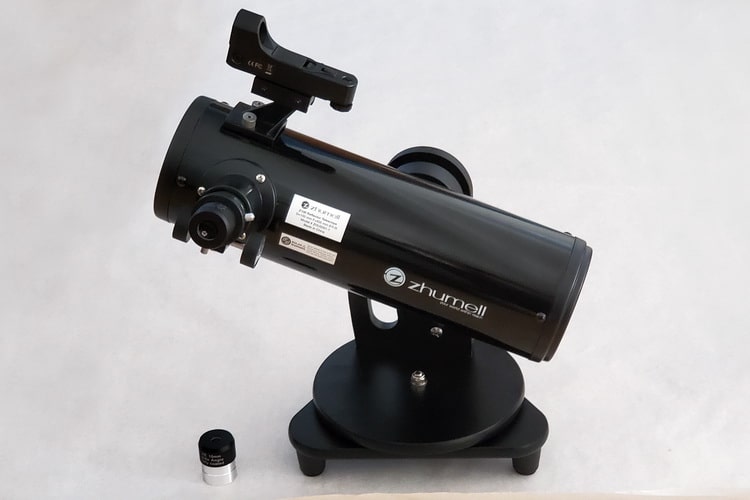
As an added bonus, it’s super easy to set-up and use, as the Dobsonian style mount is already assembled and you can start observing almost immediately. You’ll need to align the finderscope (a requirement for any telescope) but then you can simply point it toward your target and enjoy the view. This simplicity also makes it the ideal choice for families, as even younger kids will be able to use it. If there’s a downside, it’s that only one eyepiece is supplied, but these are relatively inexpensive (and you’ll end up buying more anyway!)
For more on the Zhumell Z100, check out our in-depth review.
- Compact and portable design
- Very little assembly required
- Very easy to use
- Sharp, wow-worthy views
- Lightweight
- Lacking accessories
Buying a high quality telescope doesn’t mean having to spend large amounts of cash. The Orion Observer 70mm II AZ Refractor offers outstanding optics for a very reasonable price, leaving you with plenty of money to invest in some accessories. This is a great little scope for the money, capable of producing fine views at any magnification from 10x to 175x. Its comparatively lightweight and compact design also make it a great option if you’re looking for a scope you can transport to a dark location.
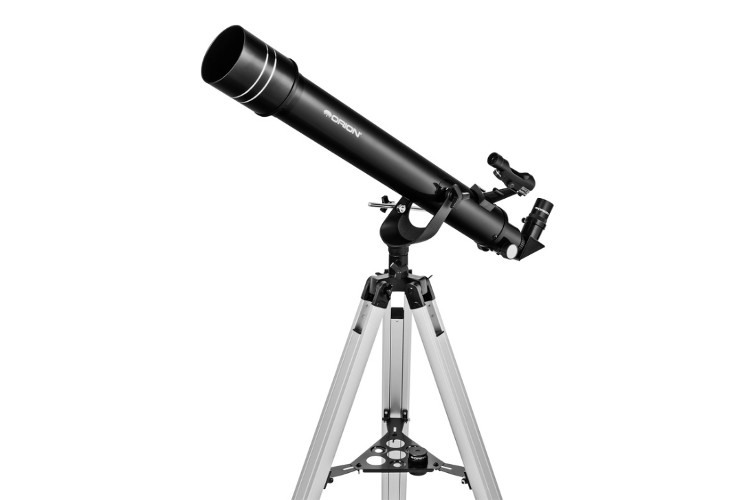
Unlike most of the other options on this list, the Observer 70mm II AZ Refractor sits upon a tripod, rather than a Dobsonian base, but it’s still very easy to set-up and use. This is a scope designed and built by a reputable manufacturer with decades of experience, so you can be sure you’ll get sharp views of the Moon, planets or almost any other celestial target you turn the telescope toward. If you’re looking for a family scope but don’t want to invest too much, then this could be the perfect choice for you.
- Excellent optics for the money
- Easy to use
- Relatively lightweight
- Tripod design makes transportation easy
- Built-in accessory tray
- Provided eyepieces are not the greatest
- May be a little tall for younger children
If you’re looking for a lightweight scope you can literally take anywhere, then the Celestron Travel Scope 80 is the one for you. Besides the included eyepieces, you’ll also get a smartphone adapter and a backpack to help you carry everything. One of the great things about this scope is that it’s also lightweight, – even with the scope and accessories packed away, the backpack will only weigh about five pounds. That also makes it a great option if you’re looking to fly, as it can be safely taken onboard a plane as a carry-on.

Hikers and campers get an additional benefit as the Travel Scope 80 can be used during the daytime too. Most telescopes will invert the image, causing targets to appear upside-down and/or flipped. This isn’t the case with the Travel Scope 80, so observers can enjoy views of the landscape around them as well as the skies above. Perhaps the biggest downside is that the tripod is a little flimsy (it’s a regular camera tripod) so you might want to invest in something a little sturdier.
For more on the Celestron Travel Scope 80, check out our in-depth review.
- Very lightweight and portable
- Quickly and easily assembled
- Good optics for the price
- Generally very easy to use
- Good for kids
- Finder isn’t good for astronomy
- Backpack doesn’t adequately hold contents in place
- Smartphone adapter is difficult to use
- Tripod is a little shaky and easily tipped over
- Mounting plate easily drops off the central column
Orion is known for producing some outstanding scopes, with their SkyQuest and Skyline Dobsonians leading the way. One of these, the SkyQuest XT6, provides the ideal balance between cost and quality, and while it can deliver the goods on almost any celestial target, it’s particularly well suited to observing the planets.
That’s because the planets are best observed at high magnification, and with a maximum magnification of 375x, the XT6 is more than capable of producing some breathtaking views.
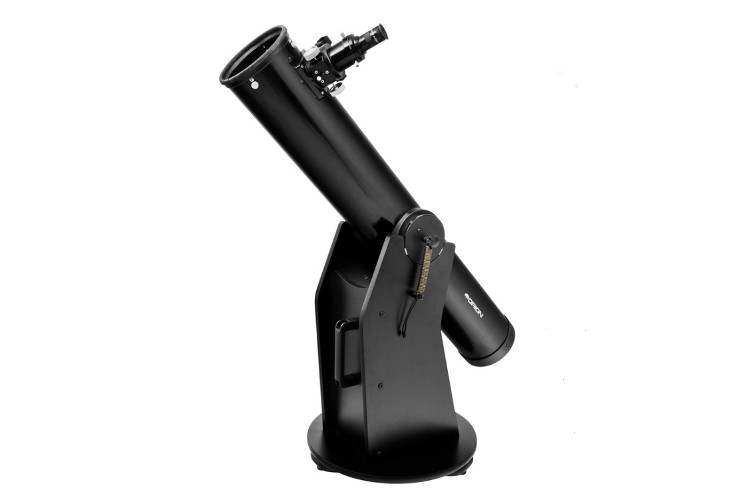
You won’t be disappointed with targets further afield either. Its minimum magnification of 21x is low enough to show larger star clusters, such as the Pleiades and Beehive clusters, in their entirety, while the generous 150mm aperture will bring thousands of galaxies within your grasp.
If there’s a downside, it’s that the scope is not the lightest (34 pounds) and while it can still be transported, it’s probably best left at home! That said, regardless of where you observe, you won’t be disappointed with the views this scope delivers.
- High magnification
- Ideal for observing the planets
- Great for fainter objects too
- Excellent value for money
- Heavy
- Only one eyepiece provided
If you’re looking for a scope that younger kids can use and enjoy, you can’t go wrong with the Celestron FirstScope. It’s the perfect size for kids of almost any age to use, and being compact and lightweight, it can also be taken on camping trips and weekends away without taking up too much space in your car or truck.
While it’s true this doesn’t have the power of a scope like the XT6 above, neither you or your kids will be disappointed with what you can see. Craters on the Moon appear sharp, while star clusters glint and nebulae show subtle colors, and you’ll have no problem spotting the moons of Jupiter or the rings of Saturn either.
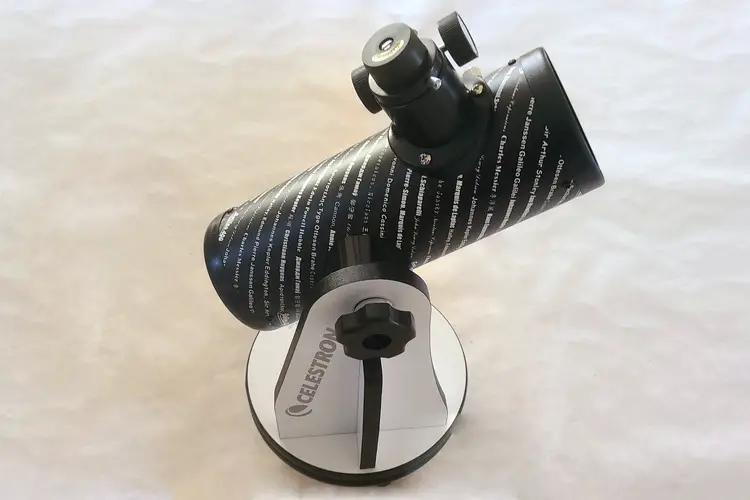
Another big plus is that there’s no assembly required – you can literally lift it out of the box and start using it immediately. (And while your kids are sure to appreciate this, it’s always a good idea to align the finderscope first!)
All that being said, a telescope is only as good as the eyepieces you use with it, and unfortunately, like many other scopes, you’ll need to buy a few eyepieces to replace the two that arrive with it. The supplied eyepieces simply won’t do justice to the scope’s capabilities, so be sure to invest in some good quality replacements to ensure your child’s love of space continues.
You can read our in-depth review of the FirstScope here.
- Super easy to use
- Good quality optics
- Compact and highly portable
- Accessible to kids of any age
- Supplied with poor quality eyepieces
- Lacks the power of other scopes
Frequently Asked Questions
Can you see the planets with a telescope?
Can I look at the Sun through a telescope?
What else can I see through a telescope?
Which accessories should I get for my telescope?
Is a Dobsonian telescope good for beginners?
Yes! Dobsonians are a great choice because there’s very little set-up, many can be easily transported to another location and they’re very easy to use. There are also some very high-quality Dobsonians that come with a fairly low price-tag, making them a very viable option for anyone just starting out.
How do you use a telescope for beginners?
As with anything new, you’ll need to familiarize yourself with the telescope and learn how best to use it. Take it outside during the day and practise locating a distant object and focusing on it. Then, try the same technique on the Moon, if it’s visible later that evening. Use a lower powered eyepiece to start with (the larger the number on the eyepiece – its focal length – the lower the magnification) and then work your way up.
What is the best telescope for beginners?
We recommend the Zhumell Z100 because it’s compact, inexpensive, produces excellent quality views and is super easy to use. It’s also lightweight and can be taken outside at a moment’s notice, making it portable and conveniently accessible should the clouds decide to suddenly clear!
How do beginners look through a telescope?
Unlike binoculars, a telescope doesn’t require the use of both eyes, so you should only use the eye that is best and most comfortable for you. For example, it might be that your eyesight is better in your left eye, rather than your right. As you look through the eyepiece, be sure to close your other eye and, if possible, cup your hands around the eyepiece to block any stray light from ruining your view.
How much should I spend on a beginner telescope?
This is really a matter of personal choice. You don’t need to spend thousands of dollars on a high-end telescope as there are some excellent choices available for under $200. However, be prepared to spend some extra cash on accessories. You’ll almost certainly need some higher-quality eyepieces, not to mention a lunar filter and a red flashlight, both of which will help to preserve your night vision.
If you’re looking for additional astronomy resources, we have a number of articles that you might find interesting.
First off, we’ve created guides on a variety of stargazing topics such as our guide to the proper cost of a telescope, our walk through of how to use a telescope for stargazing, and our guide on determining the first telescope to buy. We’ve also created as series of helpful guides, such as our list of fun facts about astronomy (which any kids or beginners will no doubt find interesting), and our astronomy guide for kids.
We’ve also created a series of buying guides, including our guide to finding the best astronomy tool, guide to finding the best telescope for beginners, and the best binoculars for astronomy.
In addition to those guides, we’ve also created a series of in-depth reviews of a variety of telescopes and astronomy binoculars. You can check them out before you buy to find out the best accessories, pros and cons for different models, and even to see what they look like unboxed. If you’re considering buying a telescope we have a series of reviews that also serve as how to guides. You can learn the following in each guide: how to use the Celestron Firstscope telescope, how to use an Orion XT6 Dobsonian Telescope, how to use the Sky-Watcher Heritage 130 Telescope, how to use the Zhumell Z100 Telescope, how to use the Celestron ExploraScope 114AZ Telescope, how to use the SkyGenius 10×50 Binoculars, how to use Orion Scenix 7×50 Binoculars, how to use Orion Astronomy 15×70 Binoculars, how to use Opticron Adventurer II 10×50 Binoculars, how to use the Celestron Travel Scope 80 Telescope, and how to use Celestron SkyMaster 20×80 Binoculars to really be able to dive into the different telescope and astronomy binocular models.
